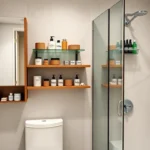Limited space doesn’t mean limited possibilities when it comes to creating your dream outdoor oasis. We’ve discovered that even the smallest backyards can transform into stunning retreats with the right design strategies and creative thinking. Whether you’re working with a tiny urban patio or a compact suburban lot, smart landscaping choices can maximize every square foot.
The key lies in understanding how to create visual depth, use vertical space, and select plants that pack maximum impact without overwhelming your area. We’ll show you proven techniques that make small spaces feel larger while maintaining functionality for relaxation and entertainment.
From clever storage answers to multi-purpose design elements, these landscaping ideas prove that size truly doesn’t matter when you have the right approach. You’ll learn how to create distinct zones, incorporate water features, and choose plants that thrive in compact environments while delivering year-round beauty.
Create Vertical Gardens to Maximize Limited Space
Vertical gardening transforms bare walls and fences into living masterpieces while freeing up precious ground space. We’ll explore three proven methods that turn your small backyard’s vertical surfaces into flourishing garden displays.
Install Wall-Mounted Planters
Wall-mounted planters offer instant garden space without sacrificing floor area for seating or walkways. We recommend selecting planters with built-in drainage systems to prevent water damage to walls and ensure healthy plant growth.
Strategic placement maximizes visual impact while creating functional growing space. Mount planters at varying heights to create ever-changing visual interest, with taller specimens like snake plants or peace lilies positioned higher and trailing varieties like pothos or ivy placed lower.
Modular planter systems allow us to expand our vertical garden over time. Products like living wall panels or pocket planters can accommodate 6-12 plants per square foot, dramatically increasing our growing capacity.
Weight distribution requires careful planning when installing multiple planters. We suggest using wall anchors rated for at least twice the expected load, accounting for soil, water, and mature plant weight.
Build Trellis Systems for Climbing Plants
Trellis systems provide support structures that guide climbing plants upward while creating natural privacy screens. We can construct simple wooden trellises using cedar or pressure-treated lumber that withstand outdoor conditions for 10-15 years.
Climbing vegetables maximize food production in minimal space through vertical growing techniques. Beans, peas, cucumbers, and tomatoes readily climb trellises, producing yields comparable to traditional garden beds while using 75% less ground space.
Flowering vines create stunning visual displays when trained on trellis frameworks. Morning glories, clematis, and climbing roses transform plain fences into colorful backdrops that bloom throughout growing seasons.
Custom trellis designs can incorporate artistic elements like geometric patterns or curved shapes. We often combine functionality with aesthetics by creating trellis panels that serve as both plant support and decorative garden features.
Use Hanging Baskets for Cascading Flowers
Hanging baskets bring garden beauty to eye level while utilizing overhead space that typically remains unused. We position hanging baskets at different heights to create layered garden displays that draw attention upward.
Trailing plant varieties excel in hanging basket environments, creating waterfall effects that soften hard landscaping edges. Petunias, bacopa, and lobelia cascade gracefully while blooming continuously through summer months.
Strategic hanging locations maximize growing conditions while improving overall garden design. We hang baskets from pergola beams, fence posts, or shepherd’s hooks positioned throughout seating areas to create intimate garden rooms.
Watering systems for hanging baskets require special consideration since elevated plantings dry out faster than ground-level gardens. Self-watering hanging baskets or drip irrigation systems reduce maintenance while ensuring consistent moisture levels.
Design Multi-Level Landscaping for Visual Depth
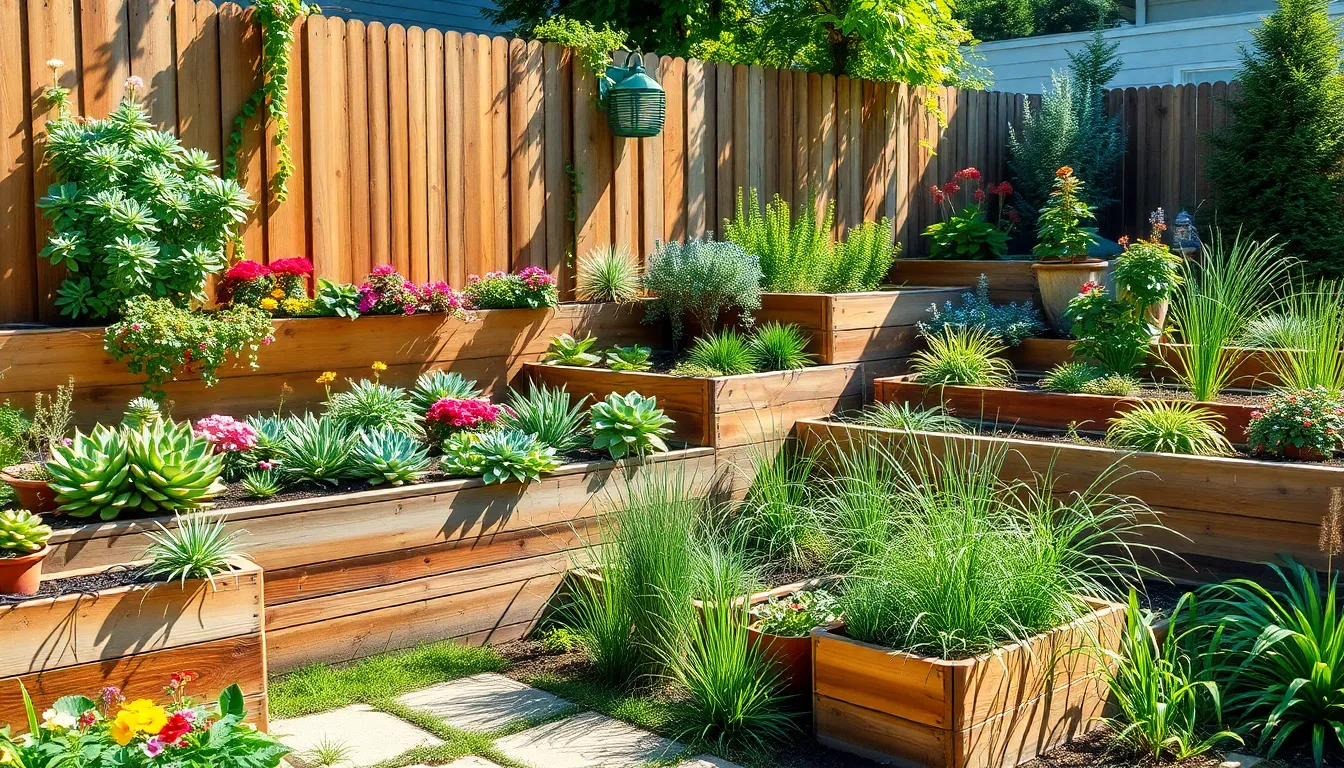
Building on vertical gardening techniques, we can create stunning depth by incorporating different elevation levels throughout our small backyard. Multi-level landscaping transforms flat spaces into ever-changing outdoor environments that feel significantly larger than their actual footprint.
Add Raised Garden Beds
Raised garden beds provide the perfect foundation for creating elevated planting areas in our compact outdoor spaces. These structures deliver better soil quality compared to ground-level planting while offering easier access for maintenance and harvesting. We can construct raised beds using materials like cedar, composite lumber, or galvanized steel to match our existing outdoor decor.
Positioning raised beds at varying heights creates natural visual layers that draw the eye upward and outward. We’ll want to place taller beds toward the back of our space and shorter ones in front to maintain clear sightlines. The elevated design also helps protect our vegetables, herbs, and flowers from ground-dwelling critters that might otherwise damage our plants.
Install Tiered Planters
Tiered planters maximize our growing space by stacking multiple planting levels in a compact footprint. These stepped arrangements work exceptionally well for growing diverse plant varieties, from cascading succulents on top tiers to leafy vegetables in lower sections. We can choose from ready-made tiered systems or build custom versions using stacked containers or wooden frames.
Strategic placement of tiered planters against walls or fences creates impressive vertical displays that serve as living artwork. The different levels allow us to group plants with similar water and sun requirements while creating beautiful color gradients from top to bottom. Corner installations work particularly well for maximizing unused space while adding dramatic focal points.
Create Sloped Garden Areas
Sloped garden areas introduce natural contours that break up flat surfaces and create interesting planting opportunities. We can build gentle slopes using soil amendments and retaining materials, then select plants that thrive in sloped conditions like ornamental grasses, ground covers, and terraced perennials. These angled surfaces catch light differently throughout the day, creating ever-changing shadow patterns that enhance visual appeal.
Natural drainage on sloped areas helps prevent water pooling while creating microclimates for different plant types. We can incorporate stepping stones or small pathways through sloped sections to maintain access for maintenance while preserving the flowing, organic appearance of the industry design.
Incorporate Space-Saving Water Features

Water features add tranquility and visual interest to small backyards without overwhelming limited space. Smart placement and compact designs create soothing ambiance while maximizing every square foot.
Install Compact Fountains
Small fountains offer easy installation and minimal maintenance requirements for busy homeowners. We recommend placing these features in corners or along pathways where they create visual interest without consuming valuable floor space. The Low Zen Sphere Fountain provides a soothing ambiance with its compact footprint, making it perfect for positioning among lush greenery.
Tiered designs like the Carrera Oval Fountain deliver maximum impact through cascading water sounds in minimal space. These three-tier models create peaceful atmospheres that transform small outdoor areas into relaxing retreats. Positioning becomes crucial as these fountains work best when integrated into existing industry elements rather than standing alone.
Add Small Pond Elements
Small ponds and koi ponds bring tranquil water elements to tight spaces without breaking budgets. We find these features particularly effective when integrated into corner areas or alongside existing hardscaping elements. Pond installations work well in small backyards because they create focal points that draw attention away from space limitations.
Maintenance requirements remain manageable with proper sizing and filtration systems designed for compact installations. These water features provide peaceful ambiance while supporting local wildlife and creating natural cooling effects during warmer months. Budget-friendly options include pre-formed pond liners that simplify installation in weekend projects.
Use Wall-Mounted Water Displays
Vertical water installations maximize impact while preserving ground space in small yards. We install these features on retaining walls where they create stunning visual displays that draw eyes upward. Wall-mounted designs expand perceived space by utilizing vertical surfaces rather than competing for limited floor area.
Boulder water features combined with river rocks create unique installations that fit narrow pathways perfectly. These designs add interest and tranquility while requiring minimal horizontal space. Strategic lighting enhances these vertical displays during evening hours, extending their visual impact throughout the day.
Choose Dwarf and Compact Plant Varieties
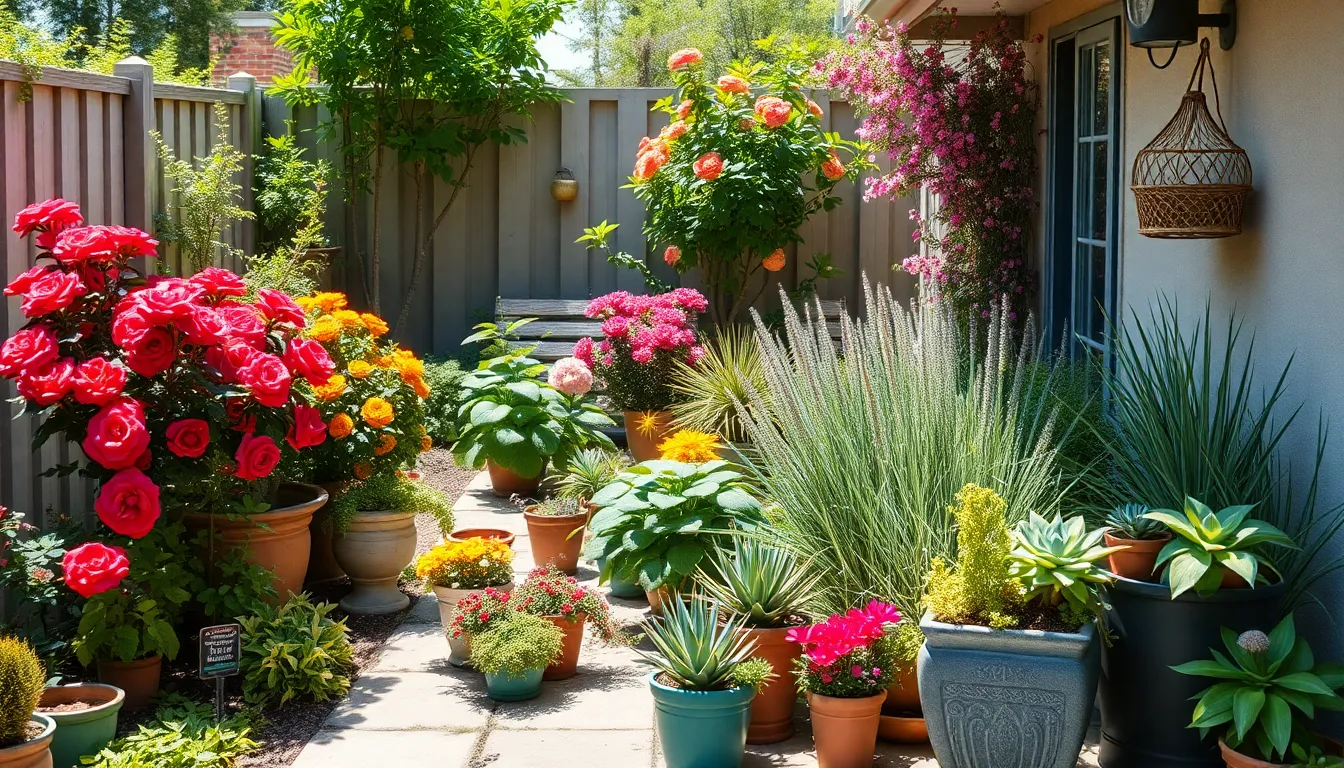
Smart plant selection transforms limited outdoor areas into lush, functional gardens. We’ll focus on compact varieties that deliver maximum visual impact without overwhelming your small backyard space.
Select Miniature Trees and Shrubs
Miniature rose bushes create stunning focal points in small backyards while providing continuous blooms throughout the growing season. These compact beauties can be trained to grow up walls or trellises, maximizing your vertical growing space while adding fragrance and color. We recommend choosing disease-resistant varieties like ‘Knockout’ roses or ‘Flower Carpet’ series for low-maintenance success.
Dwarf fruit trees offer both beauty and functionality in compact landscapes. Dwarf citrus trees thrive in containers and produce full-sized fruit while staying under 8 feet tall. Dwarf peach trees like ‘Bonfire’ or ‘Red Baron’ provide spring blossoms and summer harvests in spaces as small as 6 feet wide. Consider dwarf apple trees such as ‘Honeycrisp’ or ‘Gala’ varieties that can produce 15-20 pounds of fruit annually while maintaining a manageable 6-8 foot height.
Compact shrubs like boxwood create structure and year-round interest without consuming valuable square footage. Dwarf lilac varieties such as ‘Miss Kim’ reach only 4-5 feet tall while delivering the same fragrant spring blooms as their full-sized cousins. Japanese pieris ‘Mountain Fire’ adds evergreen structure with colorful new growth that transitions from red to green throughout the seasons.
Plant Container-Friendly Perennials
Succulents excel in small backyard environments because they’re perfectly suited for container growing and require minimal maintenance. Varieties like echeveria, sedum, and jade plants create stunning arrangements while tolerating drought conditions and small root spaces. We can arrange different succulent varieties in tiered containers to create vertical gardens that maximize growing space.
Herbs provide both beauty and functionality when grown in containers throughout your small backyard. Basil varieties like ‘Purple Ruffles’ or ‘Genovese’ thrive in pots while providing fresh ingredients for cooking. Rosemary creates attractive evergreen structure in containers while releasing fragrant oils when brushed against. Mediterranean herbs like thyme, oregano, and sage flourish in well-draining containers and return year after year.
Container-friendly flowering perennials extend your growing season and add continuous color to small spaces. Salvia varieties bloom from spring through frost in containers as small as 12 inches wide. Coneflowers (Echinacea) attract beneficial pollinators while thriving in containers with good drainage. Ornamental peppers combine edible function with decorative appeal, producing colorful fruits in compact containers throughout the growing season.
Use Ornamental Grasses for Texture
Pampas grass creates dramatic focal points in small backyards while adding movement and texture to your industry design. This striking grass produces feathery plumes that reach 6-10 feet tall, creating natural privacy screens without requiring extensive ground space. We recommend planting pampas grass in corners or along property lines where its height won’t overwhelm other plantings.
Blue oat grass provides soft, blue-green texture that complements both warm and cool-toned plantings in compact landscapes. This ornamental grass reaches 2-3 feet tall and wide, making it perfect for container growing or small garden beds. Its fine texture creates beautiful contrast against broad-leafed plants like hostas or heuchera in shaded areas of your small backyard.
Fountain grass varieties offer seasonal interest through both foliage and seed heads in small backyard settings. ‘Hameln’ dwarf fountain grass stays compact at 2 feet tall while producing attractive bottlebrush-like seed heads. Purple fountain grass adds burgundy foliage color that intensifies throughout the growing season, creating striking combinations with yellow or chartreuse companion plants.
Build Functional Hardscape Elements
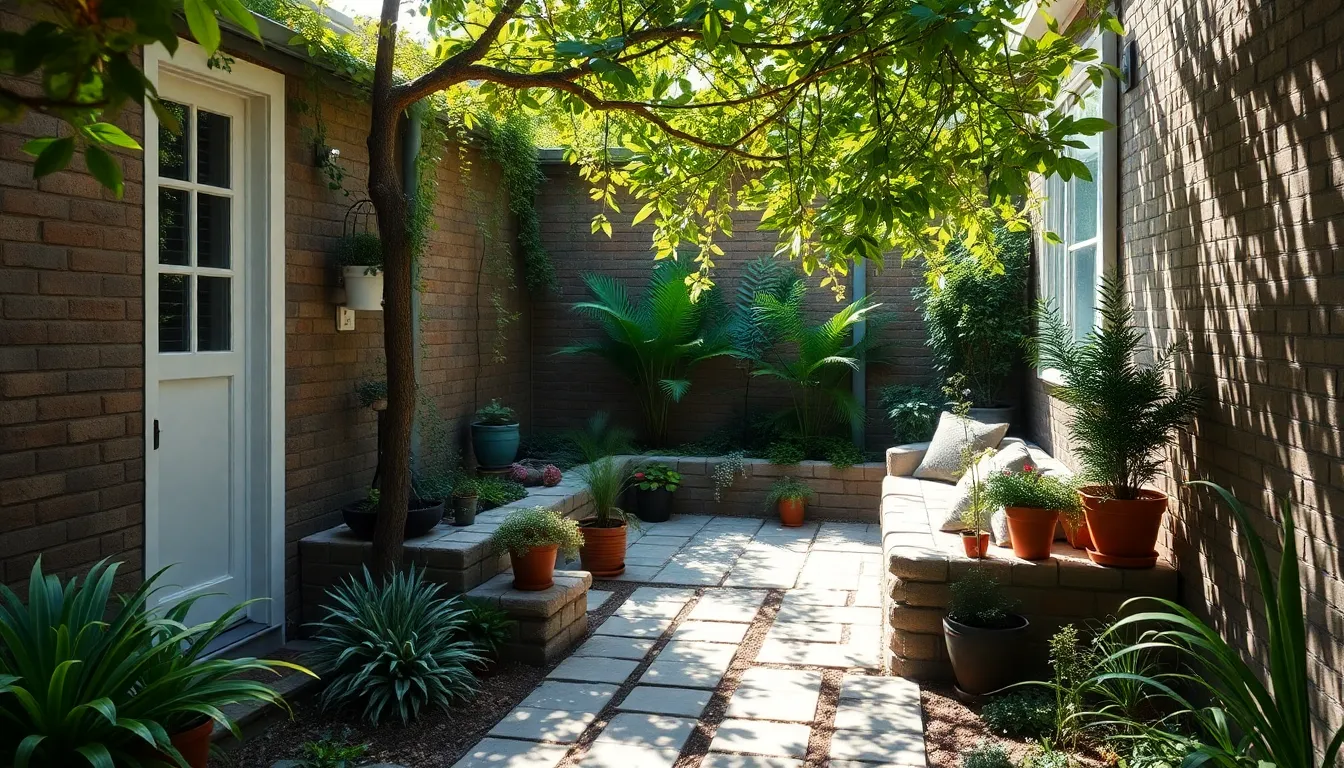
Functional hardscape elements transform small backyards into organized spaces that maximize both utility and visual appeal. These permanent features create structure while serving multiple purposes, from entertainment areas to privacy answers.
Install Narrow Pathways
Narrow pathways guide visitors through your yard without overwhelming limited space, creating natural flow between different garden areas. Materials like brick, stone, or gravel offer distinct textures that complement your overall design while remaining budget friendly. We recommend keeping pathways between 18-24 inches wide to maintain proportional scale in compact spaces.
Strategic placement of these walkways connects key features such as seating areas, garden beds, or focal points like fountains. Curved paths create an illusion of greater space by drawing the eye through longer sight lines. Gravel pathways cost approximately $1-3 per square foot, while brick installations range from $8-15 per square foot depending on your region.
Add Compact Patios or Decks
Compact patios provide essential outdoor living space for relaxation and dining without consuming your entire yard. We suggest sizing these areas based on intended use, with 8×10 feet accommodating a small dining set and 6×8 feet working perfectly for intimate seating. Materials like stamped concrete, pavers, or composite decking offer durability while maintaining visual interest.
Positioning your patio adjacent to vertical garden installations maximizes the impact of both features. Raised deck platforms work exceptionally well in sloped yards, creating level entertainment space while preserving natural drainage patterns. These elevated structures also provide storage opportunities underneath for garden tools or seasonal furniture.
Create Built-In Seating Areas
Built-in seating areas offer comfortable outdoor spots while eliminating the need for bulky furniture pieces. Bench style planters serve dual purposes by providing both seating and growing space for herbs, flowers, or small shrubs. We’ve found that 18-inch height works optimally for both comfortable seating and planter depth.
Integration with existing walls or surrounding structures reduces construction costs while creating seamless design flow. Stone or concrete benches can incorporate storage compartments underneath, hiding cushions or garden supplies. These permanent installations withstand weather conditions better than moveable furniture while maintaining consistent design aesthetics throughout seasonal changes.
Use Strategic Lighting to Expand Visual Space
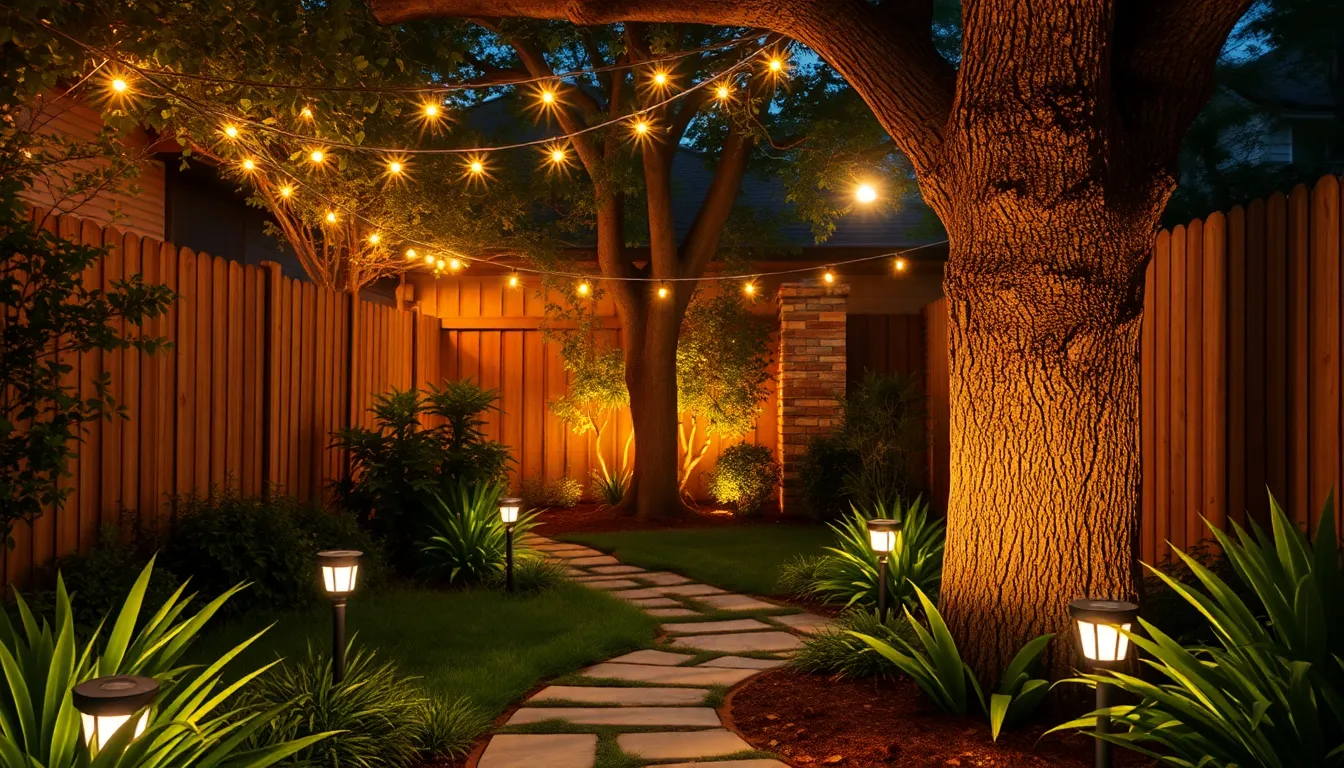
Strategic lighting transforms small backyards by creating depth and extending usable hours into the evening. We can illuminate pathways and highlight key features to make our outdoor space feel larger than its actual dimensions.
Install Solar Pathway Lights
Solar pathway lights guide visitors through our small backyard while creating visual lanes that expand perceived space. These eco-friendly fixtures eliminate electricity costs and install easily along walkways, garden borders, or between planted areas. We position them 6 to 8 feet apart for optimal illumination without overwhelming the space. The gentle glow creates depth by drawing the eye along the path, making our yard appear longer and more expansive. Solar models charge during the day and automatically illuminate at dusk, providing consistent lighting throughout the evening hours.
Add String Lights for Ambiance
String lights create a cozy atmosphere while visually lifting our small backyard’s ceiling through overhead illumination. We hang them between trees, pergolas, or fence posts to establish an intimate outdoor room feel. The warm glow makes our space more inviting during evening gatherings and extends the visual boundaries upward. LED string lights consume minimal energy and last longer than traditional bulbs, making them practical for frequent use. We can drape them in gentle curves or geometric patterns to complement our landscaping design while adding magical ambiance to dining or seating areas.
Use Uplighting for Trees and Features
Uplighting showcases vertical elements like trees, sculptures, or architectural features to create dramatic depth in our small backyard. We place spotlights at ground level pointing upward to cast interesting shadows and highlight the texture of bark, leaves, or decorative structures. This technique draws attention to our space’s height rather than its limited width, making the area feel more expansive. Well-positioned uplights can transform a single tree into a stunning focal point while creating layers of light throughout our industry design. We use low-wattage LED fixtures to minimize energy consumption while maximizing visual impact during evening hours.
Create Designated Zones for Different Activities
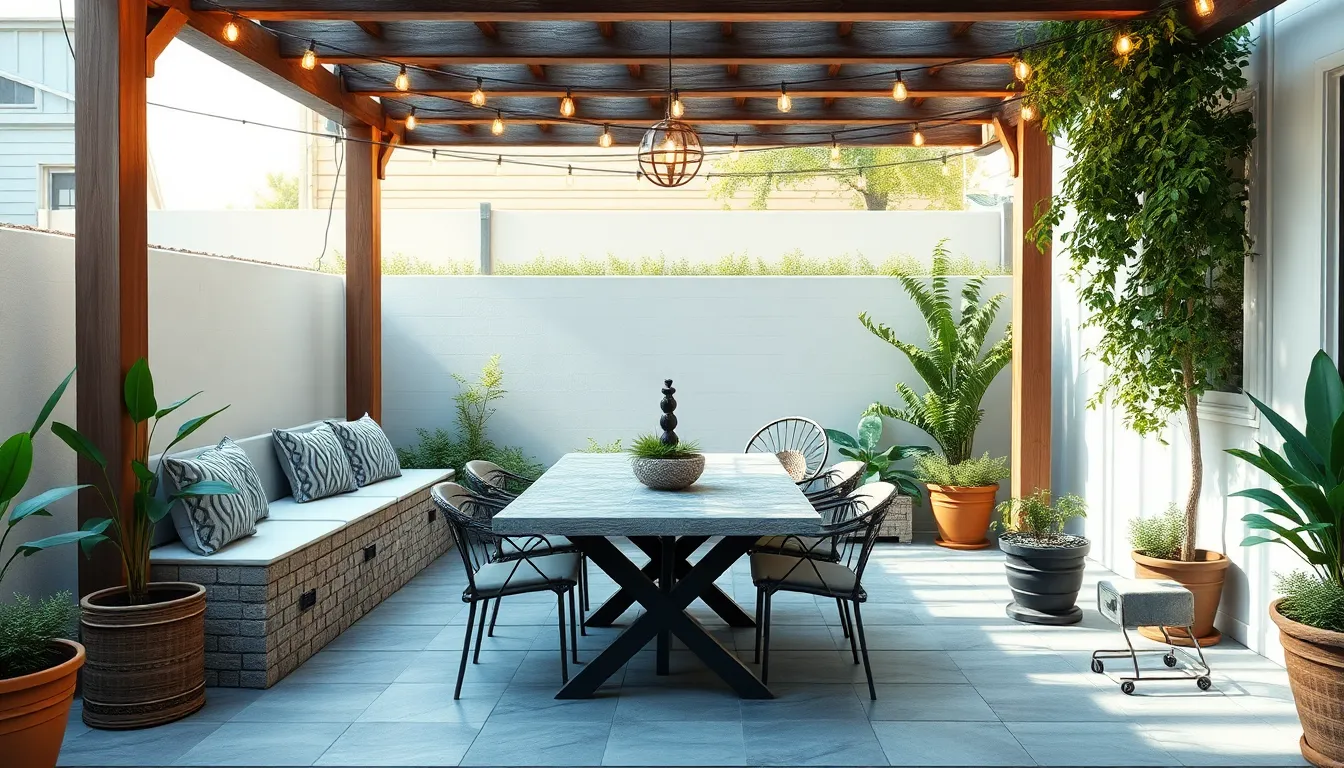
Maximizing our small backyard’s potential requires thoughtful organization of different functional areas. We’ll transform limited space into multiple zones that serve distinct purposes without creating visual clutter.
Design Dining Areas
Outdoor dining spaces create memorable gathering spots where family and friends can share meals under the open sky. We recommend using rectangular bluestone tiles to establish a symmetrical foundation that visually anchors the dining zone while providing a clean, sophisticated surface. Built-in seating eliminates the need for bulky furniture while creating permanent structure that won’t overwhelm our compact space.
Pergola placement near the dining area offers essential shade during sunny afternoons and creates intimate ambiance for evening gatherings. Overhead structures define the space vertically without consuming valuable floor area, making our dining zone feel like a proper outdoor room. String lights attached to pergola beams extend usability into evening hours while adding warm, welcoming illumination.
Table selection should prioritize functionality over size, with round or oval shapes promoting better conversation flow in tight quarters. Folding or expandable options provide flexibility for different gathering sizes without permanently consuming space when not in use.
Build Relaxation Spaces
Vertical gardens transform bare walls into living art while creating the peaceful atmosphere essential for relaxation zones. We can install wall-mounted planters or create espaliered displays that provide visual interest without consuming floor space needed for seating or movement.
Water features introduce calming sounds that mask neighborhood noise and create a spa-like environment in our compact retreat. Small fountains tucked into corners or wall-mounted displays deliver maximum tranquility without sacrificing precious square footage.
Statement fire pits serve as natural gathering points that extend our relaxation zone’s usability into cooler months. We recommend compact, portable designs that can be stored when not in use, allowing the space to serve multiple functions throughout different seasons.
Pergola structures with climbing vines create natural privacy screens while adding architectural interest to our relaxation areas. Vertical elements draw the eye upward, making small spaces feel larger while providing the seclusion necessary for true relaxation.
Establish Garden Work Zones
Raised planters provide organized growing space at comfortable working heights, reducing strain on our backs and knees during maintenance tasks. We can position these structures along property lines or use them as natural dividers between different activity zones.
Vertical containers maximize growing capacity in minimal floor space, making them perfect for herbs and vegetables in our small backyard work areas. Drought-tolerant plants and succulents thrive in these elevated environments while requiring minimal maintenance.
Storage integration within garden work zones keeps tools and supplies organized without cluttering other areas of our backyard. Built-in compartments beneath raised planters or wall-mounted storage answers maintain the clean aesthetic while providing practical functionality.
Dedicated pathways connecting garden work zones ensure easy access for maintenance without trampling other planted areas. We recommend materials like gravel or stepping stones that complement our overall design while providing stable footing during garden tasks.
Implement Container Gardening Solutions

Container gardening transforms our approach to small backyard landscaping by offering maximum flexibility without permanent ground commitment. This versatile method allows us to create stunning garden displays using vintage barrels, mixed shapes, and creative vessels that maximize every inch of available space.
Use Moveable Planters
Moveable planters give us the freedom to redesign our small backyard layout whenever inspiration strikes. We can easily relocate these containers to optimize sunlight exposure throughout the seasons or create fresh visual arrangements for special occasions.
Rolling planters work exceptionally well for heavier containers, allowing us to move established plants without strain. Lightweight materials like fiberglass or resin provide durability while keeping our containers manageable for frequent repositioning.
Hanging container gardens add vertical interest to our spaces while preserving valuable floor area. We can suspend these planters from pergolas, fence posts, or wall brackets to create cascading displays that draw the eye upward and expand our perceived space.
Balcony and patio arrangements benefit tremendously from moveable answers that adapt to changing weather conditions. During harsh storms, we can quickly relocate our most precious plants to protected areas, ensuring their survival and continued beauty.
Create Herb Garden Containers
Herb garden containers deliver both practical functionality and aromatic beauty to our small backyard spaces. We can design these gardens using small individual pots for single herbs or larger planters that accommodate multiple varieties in one convenient location.
Culinary herbs like basil, oregano, and thyme thrive in container environments while providing fresh ingredients steps away from our kitchen. These compact plants require minimal space yet offer maximum flavor impact for our cooking adventures.
Tiered herb planters create stunning visual displays while organizing our herbs by height and growth requirements. We can place taller herbs like rosemary in the back tier while showcasing shorter varieties like chives and parsley in front positions.
Window box herb gardens use narrow spaces along fences or building walls without consuming floor area. These installations keep our most frequently used herbs within easy reach while adding living color to previously unused vertical surfaces.
Design Seasonal Display Pots
Seasonal display pots keep our small backyard vibrant and captivating throughout the entire year. We can plant spring bulbs like tulips and daffodils in fall for spectacular early season blooms that herald warmer weather.
Summer containers showcase heat loving plants like petunias, marigolds, and coleus that provide continuous color through the hottest months. These displays can be easily swapped out as seasons change, maintaining fresh visual interest without major landscaping overhauls.
Fall containers filled with ornamental kale, mums, and decorative gourds create stunning autumn arrangements that celebrate harvest season. We can incorporate natural elements like corn stalks and pumpkins to enhance the seasonal theme.
Winter displays featuring evergreen boughs, holly berries, and winter flowering plants ensure our containers remain attractive even during dormant months. These cold weather arrangements provide structure and color when most other plants have gone dormant, maintaining our backyard’s appeal year round.
Add Mirrors and Reflective Elements
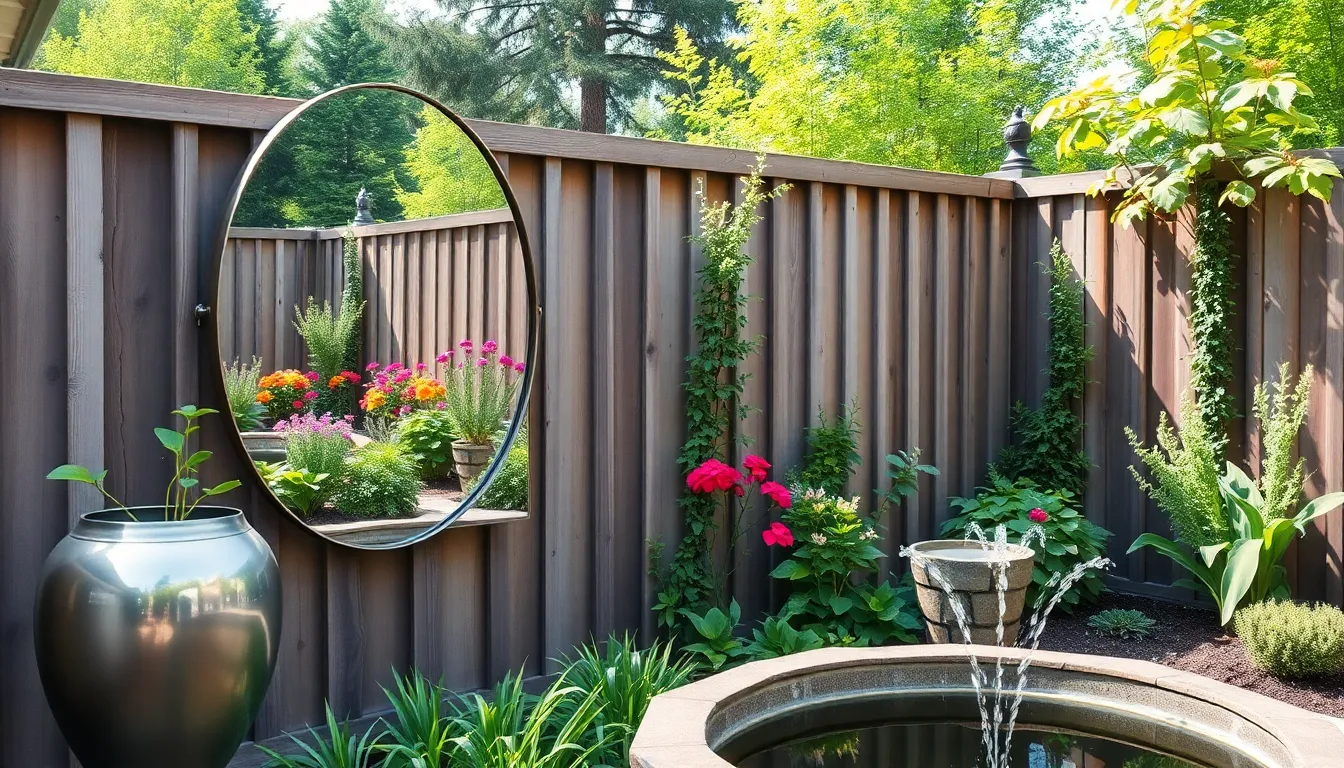
Building on our container gardening foundation, we can dramatically expand the visual boundaries of our small backyard through strategic use of mirrors and reflective materials that create the illusion of doubled space.
Install Garden Mirrors
Garden mirrors transform confined spaces by creating instant visual depth. We recommend mounting weather-resistant framed mirrors on fences or walls to double the visual impact of our plants and garden décor. This technique proves especially valuable in very small yards where every square foot demands maximum efficiency.
Strategic placement maximizes the mirror’s effectiveness. We should position mirrors to reflect our most attractive garden features, such as colorful flower beds or architectural elements. The reflection creates sightlines that extend beyond our yard’s physical boundaries, making the space feel significantly larger than its actual footprint.
Weather-resistant materials ensure long-term durability. We need to select mirrors with frames made from materials like aluminum, treated wood, or composite materials that withstand outdoor conditions. These investments protect our mirrors from moisture damage while maintaining their reflective quality throughout multiple seasons.
Use Reflective Surfaces
Reflective materials beyond traditional mirrors offer creative design opportunities. We can incorporate glass panels, polished metal accents, or mirrored tiles into garden screens, outdoor furniture, and planters to catch natural light. These elements make our backyard feel brighter and more open while adding contemporary style.
Integrated reflective elements blend seamlessly with our industry design. We might consider installing mirrored tiles within vertical garden structures or using polished stainless steel planters that reflect surrounding greenery. These subtle touches create visual interest without overwhelming our small space with obvious mirror installations.
Light-catching surfaces multiply our garden’s brightness throughout the day. We can position reflective elements to capture morning sunlight and distribute it to shadier areas of our backyard. This approach enhances plant growth while creating ever-changing lighting effects that change with the sun’s movement.
Position Water Features Strategically
Water features with reflective surfaces amplify our space expansion efforts. We can install small fountains or reflecting ponds that add movement and sound while doubling the visual impact of surrounding plants through their reflective qualities. When positioned to catch sunlight or near seating areas, these features multiply the effect of openness and tranquility.
Strategic placement near reflective elements creates compound visual effects. We should position water features where they’ll interact with our mirrors and other reflective surfaces, creating layered reflections that extend sightlines in multiple directions. This technique makes our backyard appear more multifaceted and visually complex.
Reflecting ponds serve as natural mirrors within our industry design. We can create small water features that act as horizontal mirrors, reflecting sky and surrounding plantings to visually expand our yard’s perceived height and depth. These installations work particularly well when combined with vertical gardens and overhead pergolas to create comprehensive visual expansion.
Choose Low-Maintenance Ground Cover Options
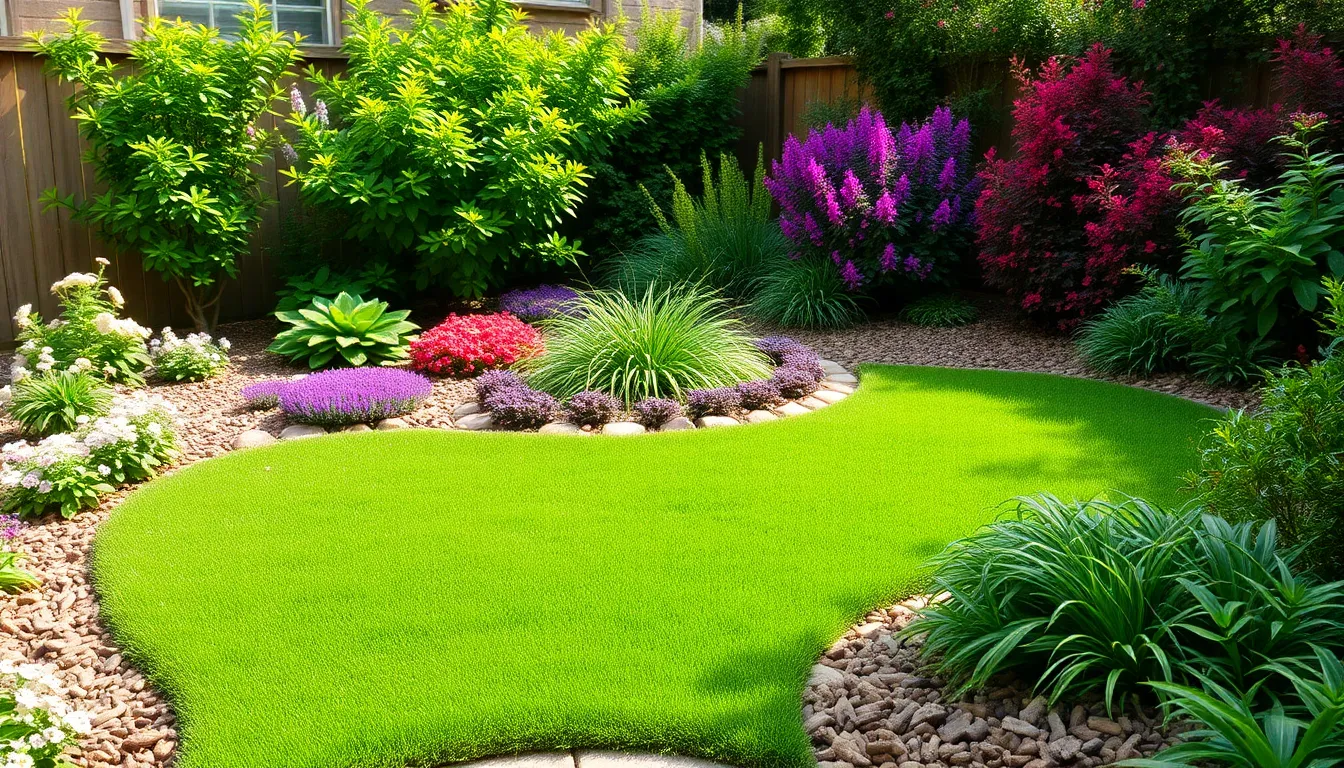
Ground cover options can dramatically reduce the time you spend maintaining your small backyard while creating a cohesive, polished appearance. We’ll explore three effective strategies that require minimal ongoing care once established.
Plant Spreading Perennials
Spreading perennials offer one of the most efficient ways to fill empty spaces in your industry without constant replanting. These hardy plants naturally expand their coverage area each growing season, reducing the need for frequent maintenance and additional purchases.
Select varieties that thrive in your local climate for the best results with minimal intervention. Native spreading perennials like wild ginger or pachysandra adapt easily to existing soil conditions and require less fertilization than non-native alternatives.
Fill gaps between larger plants using these ground-hugging varieties to create a seamless carpet effect. Creeping phlox and ajuga work particularly well for covering awkward spaces where grass struggles to grow.
Establish these plants in spring or fall when cooler temperatures help their root systems develop before extreme weather arrives. Once established, most spreading perennials return year after year with little to no additional planting required.
Use Decorative Mulch
Decorative mulch serves multiple functions while dramatically reducing your backyard maintenance workload. Wood mulch helps retain soil moisture and suppress weeds, cutting down on watering frequency and eliminating hours of weeding each season.
Apply organic wood mulch around trees and shrubs to create defined planting areas that look intentional and finished. Cedar and pine bark varieties decompose slowly, providing long-lasting coverage that feeds the soil as it breaks down.
Consider pebbles and gravel for high-traffic areas where organic mulch might get scattered or compacted. These materials require virtually no replacement and add visual appeal through varied textures and colors.
Layer mulch 2-3 inches deep around established plants to maximize weed suppression without smothering plant roots. This depth provides optimal moisture retention while preventing the mulch from washing away during heavy rains.
Install Artificial Turf Sections
Artificial turf provides an excellent solution for areas where natural grass struggles to thrive or requires excessive maintenance. Modern synthetic grass looks remarkably realistic while eliminating mowing, watering, and fertilizing from your routine entirely.
Install artificial turf in high-traffic zones where natural grass becomes worn or patchy even though regular care. These sections maintain their appearance year-round without the brown spots or bare patches common with natural lawns in small spaces.
Choose quality synthetic grass materials that feel soft underfoot and resist fading from UV exposure. Premium options include drainage backing that prevents water pooling and maintains a natural appearance even after heavy rainfall.
Combine artificial turf with living plants to create a balanced industry that feels authentic rather than completely synthetic. Border your turf sections with native ground covers or decorative mulch to blend the materials seamlessly into your overall design.
Conclusion
We’ve shown you that small backyards can become stunning outdoor retreats with the right approach. By combining vertical gardening techniques with smart plant choices and strategic lighting you’ll create spaces that feel larger and more inviting than you ever imagined.
The key lies in maximizing every element – from container gardens that adapt to your changing needs to reflective surfaces that double your visual space. These proven strategies work together to transform even the tiniest yards into functional beautiful environments.
Your small backyard isn’t a limitation – it’s an opportunity to create something truly special. Start with one or two techniques that excite you most and watch as your compact outdoor space becomes the perfect backdrop for relaxation entertainment and year-round enjoyment.
Frequently Asked Questions
How can I make my small backyard look bigger?
Use vertical gardening techniques like wall-mounted planters and trellises to maximize space. Install strategic lighting such as uplighting and string lights to create depth. Add mirrors on fences to create the illusion of doubled space. Incorporate multi-level landscaping with raised beds and tiered planters to add visual interest and depth.
What are the best plants for small outdoor spaces?
Choose dwarf and compact varieties like miniature trees, disease-resistant rose bushes, and dwarf fruit trees. Container-friendly perennials such as succulents and herbs work well in limited spaces. Ornamental grasses like pampas grass and blue oat grass add texture while creating natural privacy screens without overwhelming the area.
How do I create different zones in a small backyard?
Design designated areas for specific activities using hardscape elements. Create outdoor dining spaces with built-in seating and pergolas for shade. Establish relaxation zones with vertical gardens and water features. Set up garden work areas with raised planters and integrated storage. Connect zones with narrow pathways for easy access.
What water features work best in small spaces?
Compact fountains can be installed in corners or along pathways for soothing ambiance. Tiered fountains like the Carrera Oval Fountain deliver maximum impact with minimal space. Small ponds serve as focal points while supporting wildlife. Wall-mounted water displays maximize impact while preserving ground space using vertical surfaces.
How can container gardening help maximize small backyard space?
Container gardening offers flexibility with moveable planters that allow easy redesign and optimal sunlight exposure. Hanging container gardens add vertical interest without using floor space. Herb garden containers provide practical functionality, while seasonal display pots keep the backyard vibrant year-round with rotating plant varieties.
What lighting strategies work best for small outdoor areas?
Solar pathway lights illuminate walkways and create visual lanes to enhance space perception. String lights add ambiance and visually lift the area’s ceiling. Uplighting showcases vertical elements like trees and sculptures, creating dramatic depth. These techniques extend usability into evening hours while making spaces appear larger.
How do I incorporate storage in a small backyard design?
Integrate built-in seating with hidden storage compartments to eliminate bulky furniture. Use raised planters with storage capabilities for garden tools and supplies. Install vertical containers that double as storage solutions. Design multi-purpose elements that serve both functional and aesthetic purposes while maintaining a clean, organized appearance.
What are low-maintenance landscaping options for small spaces?
Ground cover plants require minimal care once established and naturally spread to fill empty spaces. Decorative mulch retains moisture, suppresses weeds, and creates a polished appearance. Artificial turf provides a realistic look in high-traffic areas without natural grass upkeep. These options reduce maintenance while enhancing backyard beauty.





